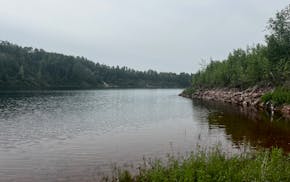The state continues to investigate a mysterious sheen that stretched along the Mississippi River upstream of the drinking water intakes for both Minneapolis and St. Paul — and now say another area of suspiciously shiny water was spotted by Coon Rapids Dam Regional Park.
Evidence of contamination in the river was first reported shortly after noon Tuesday, stretching from the Hwy. 610 bridge in Coon Rapids about two miles downstream. Maddison Zikmund, the Fridley fire chief, said initial testing was inconclusive and did not suggest the sheen was caused by a fuel spill, though "it absolutely looked like that."
The sheen dissipated and was largely gone by nightfall, Zikmund said. But the Minnesota Pollution Control Agency said it received a report of a second sheen on Wednesday morning, by the park in Coon Rapids, and is investigating whether it's connected to the earlier event.
"The type of substance is still unknown," MPCA spokesman Michael Rafferty wrote in an email.
Amy Barrett, a spokeswoman for the Minnesota Department of Health, said test results on samples of the water would be ready on Thursday morning.
The water treatment plants for Minneapolis and St. Paul both draw river water downstream of where the sheen was reported. MPCA said that booms had been put in the river around each intake to block any possible pollution.
St. Paul Regional Water Services immediately shut down its intake for river water after the sheen was reported, a spokesperson wrote in an email. It remained shut off on Wednesday, and the system was using other water sources. System general Manager Racquel Vaske said Tuesday that the city's drinking water customers would not be affected.
In addition to the river, the regional system has wells and a chain of lakes it can use for supply.
A spokesperson for the city of Minneapolis wrote in an email that the city's water was "safe and unaffected." The city relies entirely on the Mississippi, and the statement said it had briefly turned off its intake but resumed treating river water on Wednesday morning.
Minneapolis was had added some precautions to its treatment process, including extra filtering and using water deeper below the surface of the river, according to the city's statement.
Anderson: He paddled solo into the BWCA and didn't come back

Accomplished climber, photographer who recently moved from St. Paul missing on mountain
dj](https://arc.stimg.co/startribunemedia/34QSKO44B2XKVNUZCO5SLJQSLY.jpg?h=91&w=145&fit=crop&bg=999&crop=faces)
Some adults will soon need a permit to operate a boat or personal watercraft in Minnesota

